An Analysis of Business Ethics: London Transport and Student Fares
VerifiedAdded on 2020/12/30
|7
|1518
|76
Report
AI Summary
This report investigates the impact of London's public transport prices on students, focusing on the ethical considerations of fare structures and their effects on student travel. The research includes a brief literature review, outlining existing studies on the demand for public transport, fare elasticity, and student travel patterns. The research aims to determine the importance of public transport in London, evaluate student opinions on fares, and examine the role of Transport for London (TfL). The methodology involves qualitative primary data collection through interviews with 300 students, and a detailed time scale is provided, outlining the stages of research from proposal design to recommendations. The report highlights the availability of discounted fares, such as the Student Oyster Card, and compares the costs of different transport modes. The conclusion aims to provide insights into the affordability and accessibility of London's public transport for students.
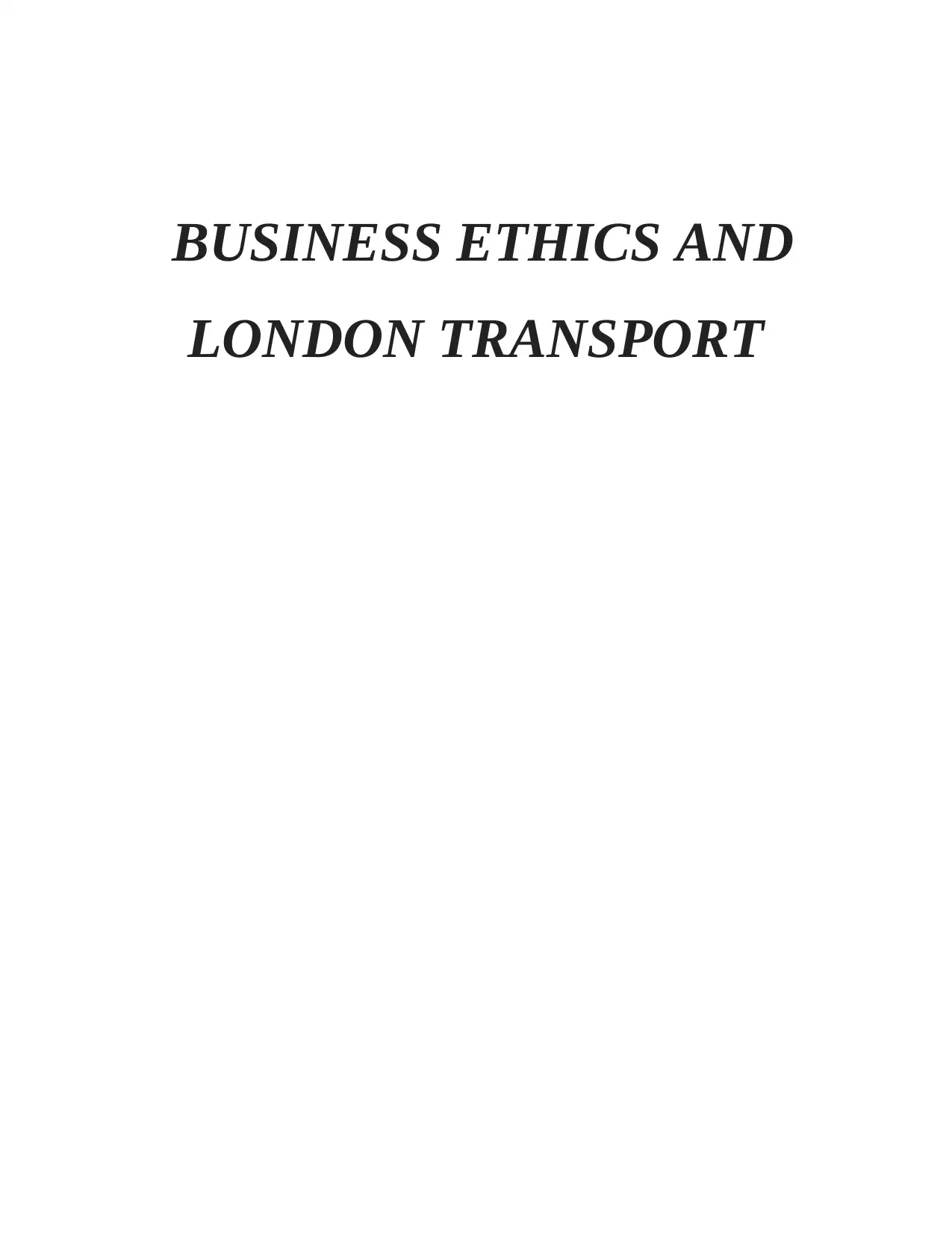
BUSINESS ETHICS AND
LONDON TRANSPORT
LONDON TRANSPORT
Paraphrase This Document
Need a fresh take? Get an instant paraphrase of this document with our AI Paraphraser
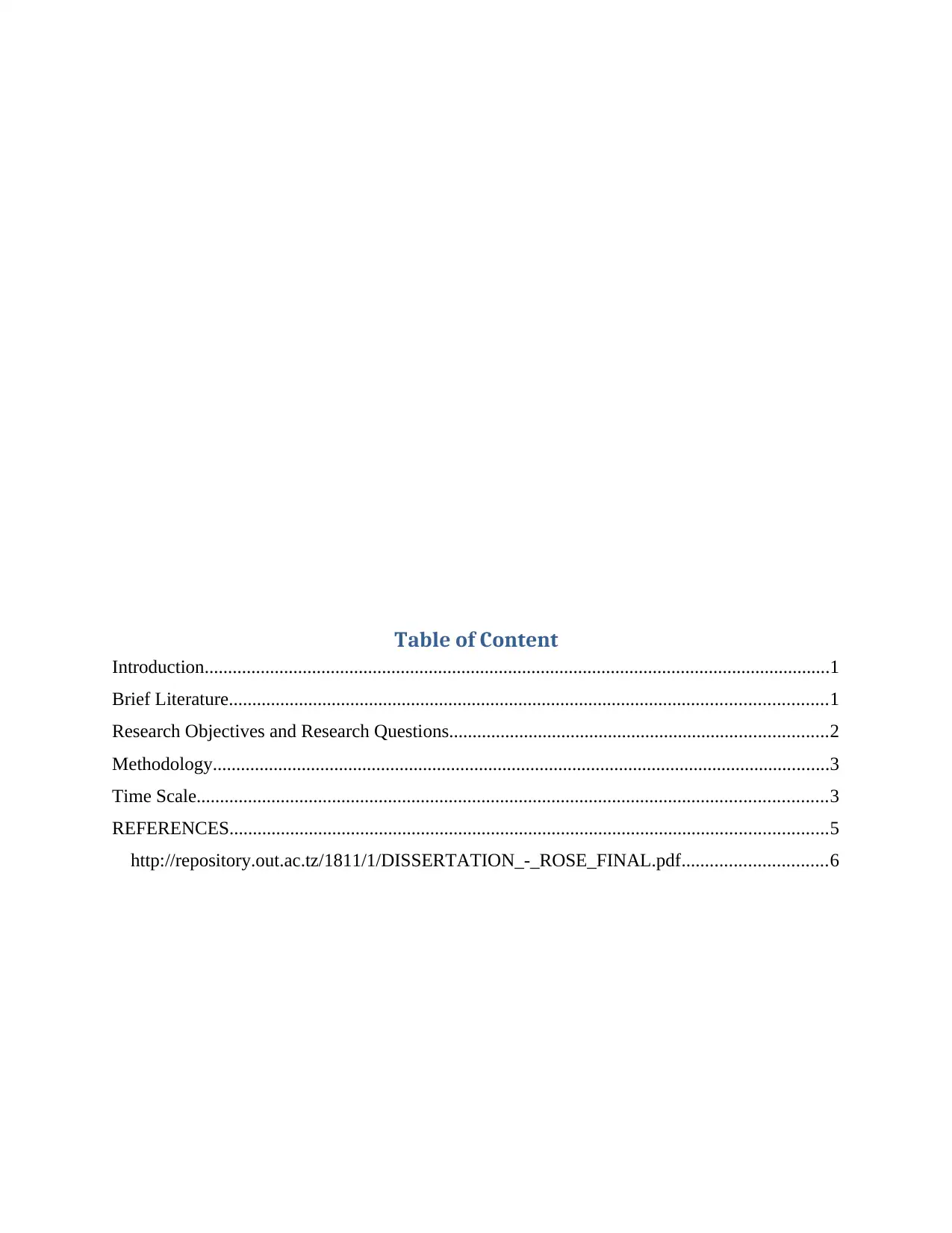
Table of Content
Introduction......................................................................................................................................1
Brief Literature................................................................................................................................1
Research Objectives and Research Questions.................................................................................2
Methodology....................................................................................................................................3
Time Scale.......................................................................................................................................3
REFERENCES................................................................................................................................5
http://repository.out.ac.tz/1811/1/DISSERTATION_-_ROSE_FINAL.pdf...............................6
Introduction......................................................................................................................................1
Brief Literature................................................................................................................................1
Research Objectives and Research Questions.................................................................................2
Methodology....................................................................................................................................3
Time Scale.......................................................................................................................................3
REFERENCES................................................................................................................................5
http://repository.out.ac.tz/1811/1/DISSERTATION_-_ROSE_FINAL.pdf...............................6
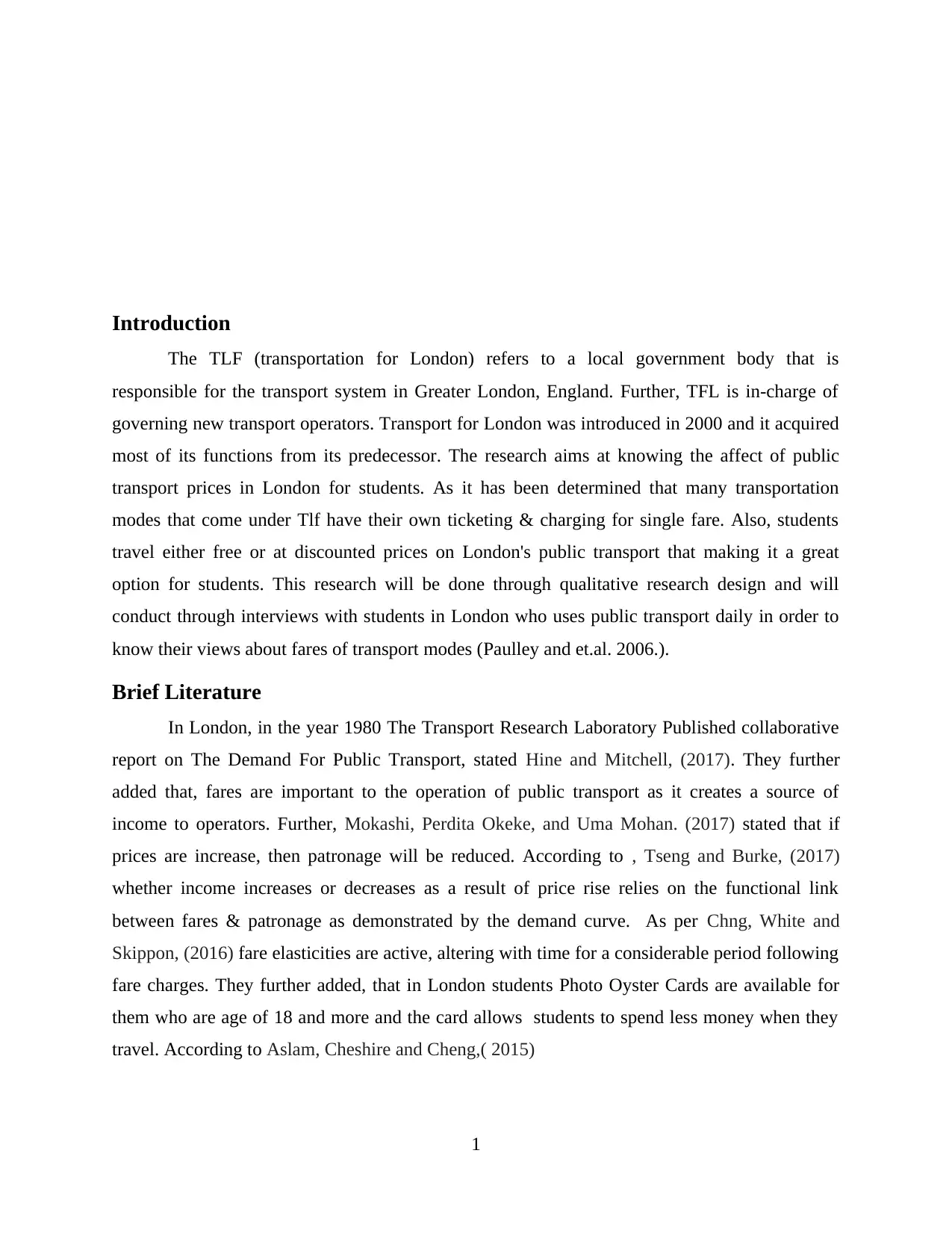
Introduction
The TLF (transportation for London) refers to a local government body that is
responsible for the transport system in Greater London, England. Further, TFL is in-charge of
governing new transport operators. Transport for London was introduced in 2000 and it acquired
most of its functions from its predecessor. The research aims at knowing the affect of public
transport prices in London for students. As it has been determined that many transportation
modes that come under Tlf have their own ticketing & charging for single fare. Also, students
travel either free or at discounted prices on London's public transport that making it a great
option for students. This research will be done through qualitative research design and will
conduct through interviews with students in London who uses public transport daily in order to
know their views about fares of transport modes (Paulley and et.al. 2006.).
Brief Literature
In London, in the year 1980 The Transport Research Laboratory Published collaborative
report on The Demand For Public Transport, stated Hine and Mitchell, (2017). They further
added that, fares are important to the operation of public transport as it creates a source of
income to operators. Further, Mokashi, Perdita Okeke, and Uma Mohan. (2017) stated that if
prices are increase, then patronage will be reduced. According to , Tseng and Burke, (2017)
whether income increases or decreases as a result of price rise relies on the functional link
between fares & patronage as demonstrated by the demand curve. As per Chng, White and
Skippon, (2016) fare elasticities are active, altering with time for a considerable period following
fare charges. They further added, that in London students Photo Oyster Cards are available for
them who are age of 18 and more and the card allows students to spend less money when they
travel. According to Aslam, Cheshire and Cheng,( 2015)
1
The TLF (transportation for London) refers to a local government body that is
responsible for the transport system in Greater London, England. Further, TFL is in-charge of
governing new transport operators. Transport for London was introduced in 2000 and it acquired
most of its functions from its predecessor. The research aims at knowing the affect of public
transport prices in London for students. As it has been determined that many transportation
modes that come under Tlf have their own ticketing & charging for single fare. Also, students
travel either free or at discounted prices on London's public transport that making it a great
option for students. This research will be done through qualitative research design and will
conduct through interviews with students in London who uses public transport daily in order to
know their views about fares of transport modes (Paulley and et.al. 2006.).
Brief Literature
In London, in the year 1980 The Transport Research Laboratory Published collaborative
report on The Demand For Public Transport, stated Hine and Mitchell, (2017). They further
added that, fares are important to the operation of public transport as it creates a source of
income to operators. Further, Mokashi, Perdita Okeke, and Uma Mohan. (2017) stated that if
prices are increase, then patronage will be reduced. According to , Tseng and Burke, (2017)
whether income increases or decreases as a result of price rise relies on the functional link
between fares & patronage as demonstrated by the demand curve. As per Chng, White and
Skippon, (2016) fare elasticities are active, altering with time for a considerable period following
fare charges. They further added, that in London students Photo Oyster Cards are available for
them who are age of 18 and more and the card allows students to spend less money when they
travel. According to Aslam, Cheshire and Cheng,( 2015)
1
⊘ This is a preview!⊘
Do you want full access?
Subscribe today to unlock all pages.

Trusted by 1+ million students worldwide
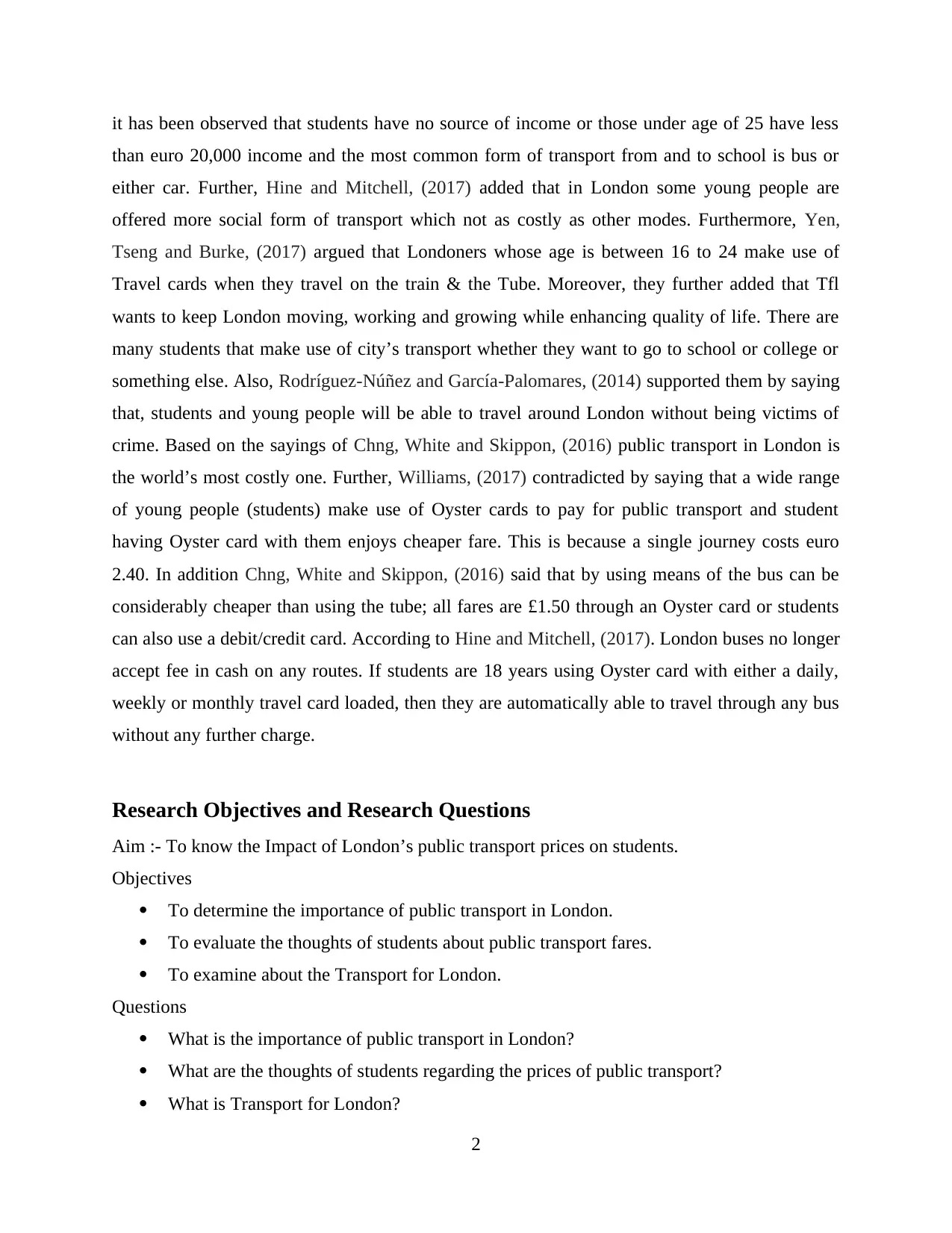
it has been observed that students have no source of income or those under age of 25 have less
than euro 20,000 income and the most common form of transport from and to school is bus or
either car. Further, Hine and Mitchell, (2017) added that in London some young people are
offered more social form of transport which not as costly as other modes. Furthermore, Yen,
Tseng and Burke, (2017) argued that Londoners whose age is between 16 to 24 make use of
Travel cards when they travel on the train & the Tube. Moreover, they further added that Tfl
wants to keep London moving, working and growing while enhancing quality of life. There are
many students that make use of city’s transport whether they want to go to school or college or
something else. Also, Rodríguez-Núñez and García-Palomares, (2014) supported them by saying
that, students and young people will be able to travel around London without being victims of
crime. Based on the sayings of Chng, White and Skippon, (2016) public transport in London is
the world’s most costly one. Further, Williams, (2017) contradicted by saying that a wide range
of young people (students) make use of Oyster cards to pay for public transport and student
having Oyster card with them enjoys cheaper fare. This is because a single journey costs euro
2.40. In addition Chng, White and Skippon, (2016) said that by using means of the bus can be
considerably cheaper than using the tube; all fares are £1.50 through an Oyster card or students
can also use a debit/credit card. According to Hine and Mitchell, (2017). London buses no longer
accept fee in cash on any routes. If students are 18 years using Oyster card with either a daily,
weekly or monthly travel card loaded, then they are automatically able to travel through any bus
without any further charge.
Research Objectives and Research Questions
Aim :- To know the Impact of London’s public transport prices on students.
Objectives
To determine the importance of public transport in London.
To evaluate the thoughts of students about public transport fares.
To examine about the Transport for London.
Questions
What is the importance of public transport in London?
What are the thoughts of students regarding the prices of public transport?
What is Transport for London?
2
than euro 20,000 income and the most common form of transport from and to school is bus or
either car. Further, Hine and Mitchell, (2017) added that in London some young people are
offered more social form of transport which not as costly as other modes. Furthermore, Yen,
Tseng and Burke, (2017) argued that Londoners whose age is between 16 to 24 make use of
Travel cards when they travel on the train & the Tube. Moreover, they further added that Tfl
wants to keep London moving, working and growing while enhancing quality of life. There are
many students that make use of city’s transport whether they want to go to school or college or
something else. Also, Rodríguez-Núñez and García-Palomares, (2014) supported them by saying
that, students and young people will be able to travel around London without being victims of
crime. Based on the sayings of Chng, White and Skippon, (2016) public transport in London is
the world’s most costly one. Further, Williams, (2017) contradicted by saying that a wide range
of young people (students) make use of Oyster cards to pay for public transport and student
having Oyster card with them enjoys cheaper fare. This is because a single journey costs euro
2.40. In addition Chng, White and Skippon, (2016) said that by using means of the bus can be
considerably cheaper than using the tube; all fares are £1.50 through an Oyster card or students
can also use a debit/credit card. According to Hine and Mitchell, (2017). London buses no longer
accept fee in cash on any routes. If students are 18 years using Oyster card with either a daily,
weekly or monthly travel card loaded, then they are automatically able to travel through any bus
without any further charge.
Research Objectives and Research Questions
Aim :- To know the Impact of London’s public transport prices on students.
Objectives
To determine the importance of public transport in London.
To evaluate the thoughts of students about public transport fares.
To examine about the Transport for London.
Questions
What is the importance of public transport in London?
What are the thoughts of students regarding the prices of public transport?
What is Transport for London?
2
Paraphrase This Document
Need a fresh take? Get an instant paraphrase of this document with our AI Paraphraser
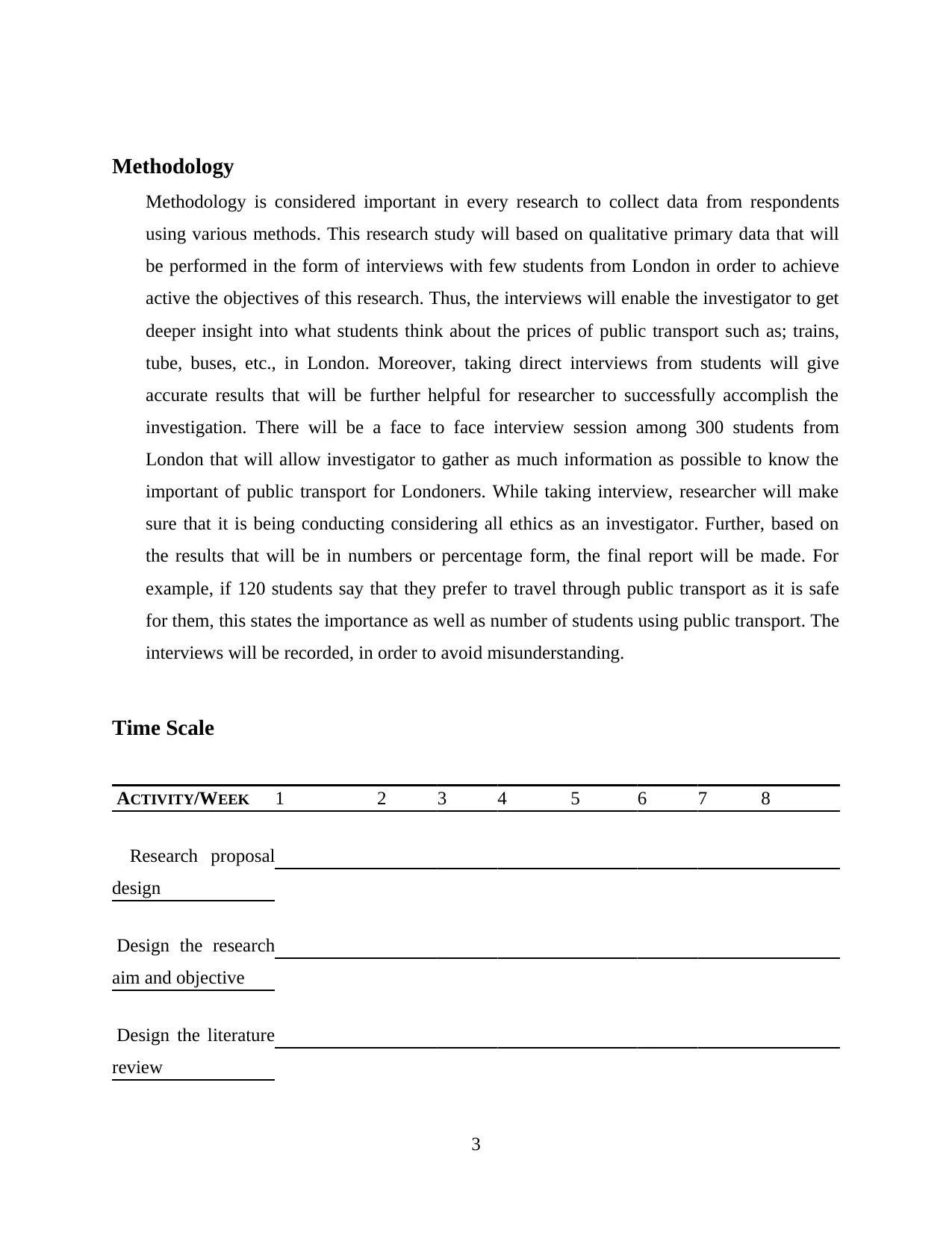
Methodology
Methodology is considered important in every research to collect data from respondents
using various methods. This research study will based on qualitative primary data that will
be performed in the form of interviews with few students from London in order to achieve
active the objectives of this research. Thus, the interviews will enable the investigator to get
deeper insight into what students think about the prices of public transport such as; trains,
tube, buses, etc., in London. Moreover, taking direct interviews from students will give
accurate results that will be further helpful for researcher to successfully accomplish the
investigation. There will be a face to face interview session among 300 students from
London that will allow investigator to gather as much information as possible to know the
important of public transport for Londoners. While taking interview, researcher will make
sure that it is being conducting considering all ethics as an investigator. Further, based on
the results that will be in numbers or percentage form, the final report will be made. For
example, if 120 students say that they prefer to travel through public transport as it is safe
for them, this states the importance as well as number of students using public transport. The
interviews will be recorded, in order to avoid misunderstanding.
Time Scale
ACTIVITY/WEEK 1 2 3 4 5 6 7 8
Research proposal
design
Design the research
aim and objective
Design the literature
review
3
Methodology is considered important in every research to collect data from respondents
using various methods. This research study will based on qualitative primary data that will
be performed in the form of interviews with few students from London in order to achieve
active the objectives of this research. Thus, the interviews will enable the investigator to get
deeper insight into what students think about the prices of public transport such as; trains,
tube, buses, etc., in London. Moreover, taking direct interviews from students will give
accurate results that will be further helpful for researcher to successfully accomplish the
investigation. There will be a face to face interview session among 300 students from
London that will allow investigator to gather as much information as possible to know the
important of public transport for Londoners. While taking interview, researcher will make
sure that it is being conducting considering all ethics as an investigator. Further, based on
the results that will be in numbers or percentage form, the final report will be made. For
example, if 120 students say that they prefer to travel through public transport as it is safe
for them, this states the importance as well as number of students using public transport. The
interviews will be recorded, in order to avoid misunderstanding.
Time Scale
ACTIVITY/WEEK 1 2 3 4 5 6 7 8
Research proposal
design
Design the research
aim and objective
Design the literature
review
3
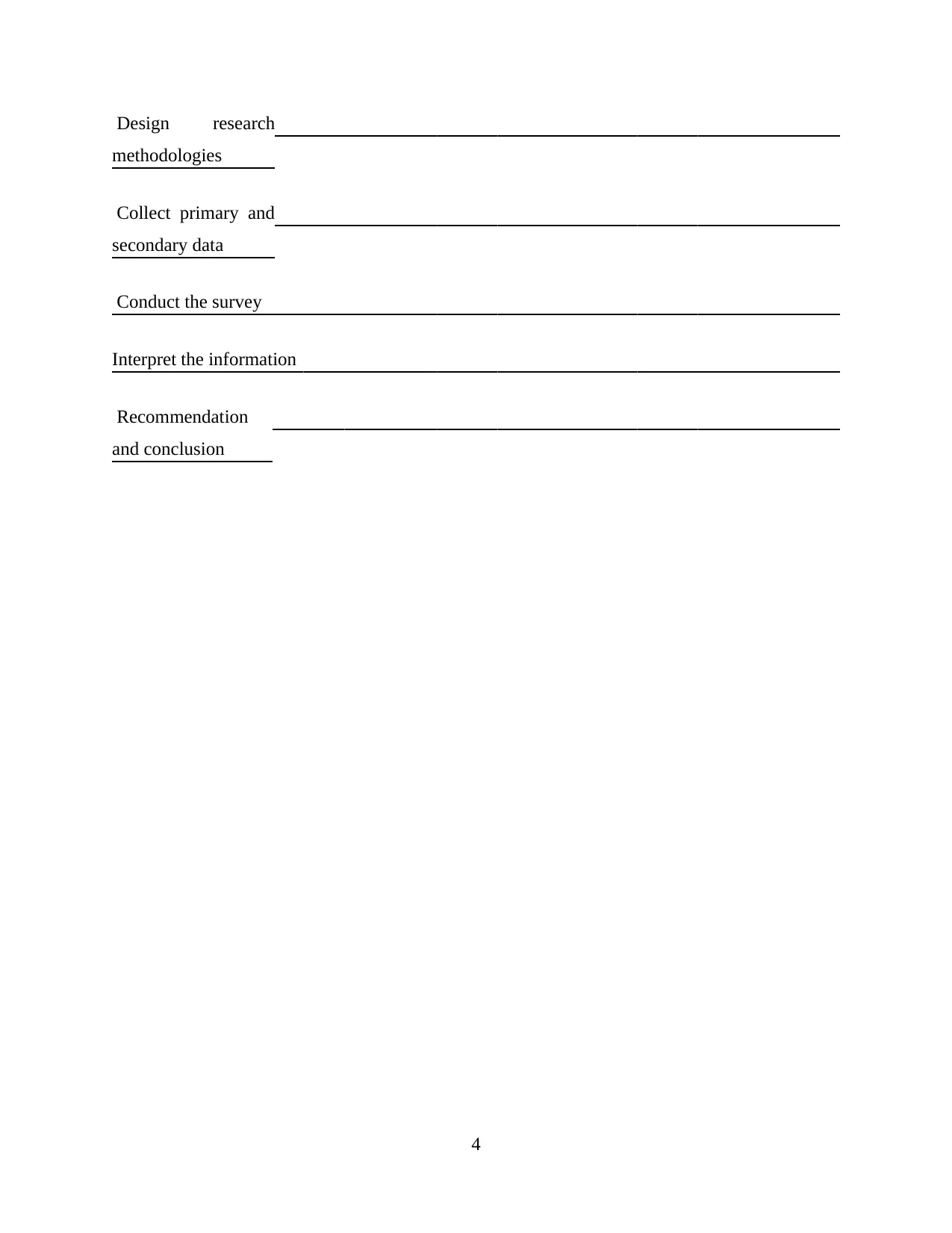
Design research
methodologies
Collect primary and
secondary data
Conduct the survey
Interpret the information
Recommendation
and conclusion
4
methodologies
Collect primary and
secondary data
Conduct the survey
Interpret the information
Recommendation
and conclusion
4
⊘ This is a preview!⊘
Do you want full access?
Subscribe today to unlock all pages.

Trusted by 1+ million students worldwide
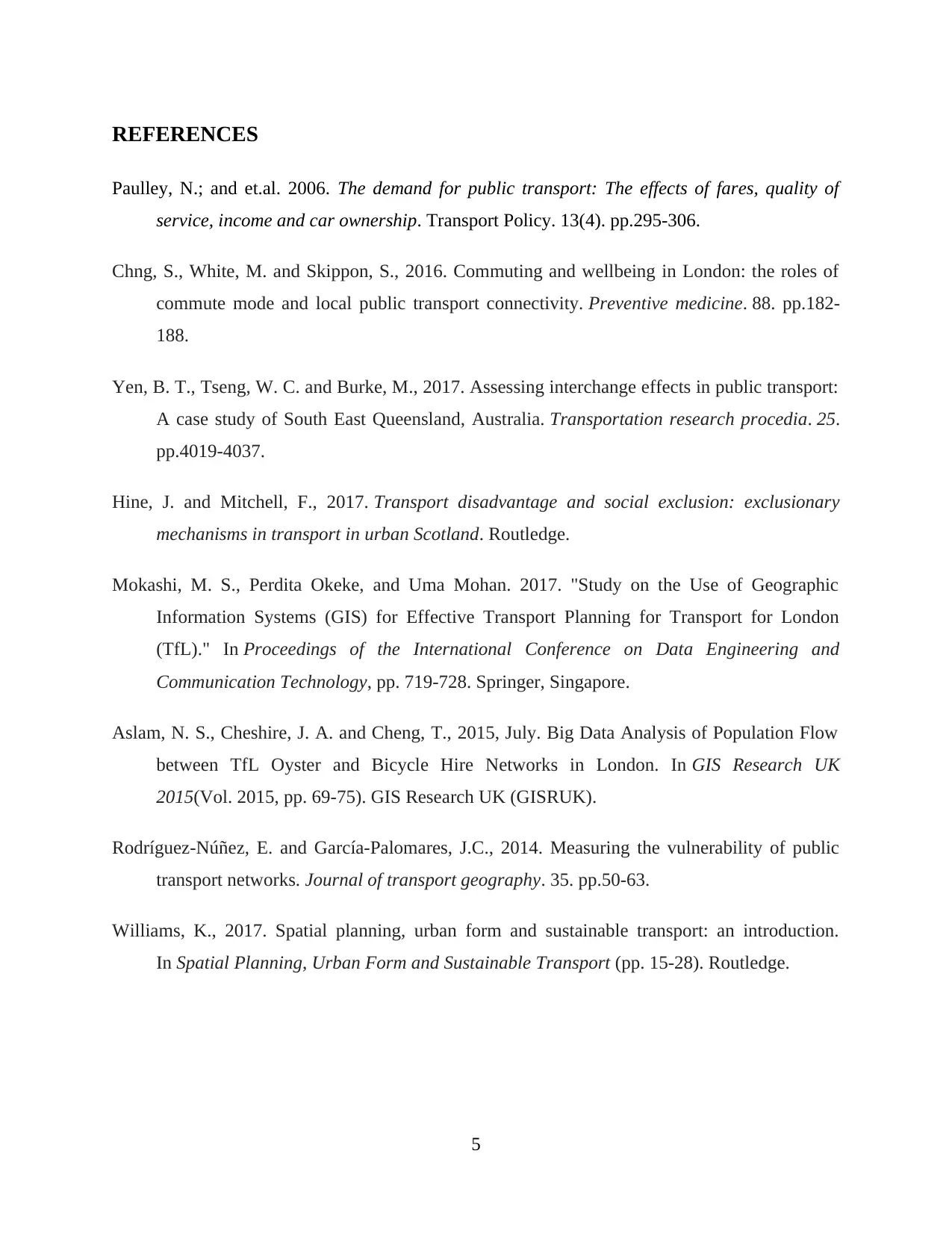
REFERENCES
Paulley, N.; and et.al. 2006. The demand for public transport: The effects of fares, quality of
service, income and car ownership. Transport Policy. 13(4). pp.295-306.
Chng, S., White, M. and Skippon, S., 2016. Commuting and wellbeing in London: the roles of
commute mode and local public transport connectivity. Preventive medicine. 88. pp.182-
188.
Yen, B. T., Tseng, W. C. and Burke, M., 2017. Assessing interchange effects in public transport:
A case study of South East Queensland, Australia. Transportation research procedia. 25.
pp.4019-4037.
Hine, J. and Mitchell, F., 2017. Transport disadvantage and social exclusion: exclusionary
mechanisms in transport in urban Scotland. Routledge.
Mokashi, M. S., Perdita Okeke, and Uma Mohan. 2017. "Study on the Use of Geographic
Information Systems (GIS) for Effective Transport Planning for Transport for London
(TfL)." In Proceedings of the International Conference on Data Engineering and
Communication Technology, pp. 719-728. Springer, Singapore.
Aslam, N. S., Cheshire, J. A. and Cheng, T., 2015, July. Big Data Analysis of Population Flow
between TfL Oyster and Bicycle Hire Networks in London. In GIS Research UK
2015(Vol. 2015, pp. 69-75). GIS Research UK (GISRUK).
Rodríguez-Núñez, E. and García-Palomares, J.C., 2014. Measuring the vulnerability of public
transport networks. Journal of transport geography. 35. pp.50-63.
Williams, K., 2017. Spatial planning, urban form and sustainable transport: an introduction.
In Spatial Planning, Urban Form and Sustainable Transport (pp. 15-28). Routledge.
5
Paulley, N.; and et.al. 2006. The demand for public transport: The effects of fares, quality of
service, income and car ownership. Transport Policy. 13(4). pp.295-306.
Chng, S., White, M. and Skippon, S., 2016. Commuting and wellbeing in London: the roles of
commute mode and local public transport connectivity. Preventive medicine. 88. pp.182-
188.
Yen, B. T., Tseng, W. C. and Burke, M., 2017. Assessing interchange effects in public transport:
A case study of South East Queensland, Australia. Transportation research procedia. 25.
pp.4019-4037.
Hine, J. and Mitchell, F., 2017. Transport disadvantage and social exclusion: exclusionary
mechanisms in transport in urban Scotland. Routledge.
Mokashi, M. S., Perdita Okeke, and Uma Mohan. 2017. "Study on the Use of Geographic
Information Systems (GIS) for Effective Transport Planning for Transport for London
(TfL)." In Proceedings of the International Conference on Data Engineering and
Communication Technology, pp. 719-728. Springer, Singapore.
Aslam, N. S., Cheshire, J. A. and Cheng, T., 2015, July. Big Data Analysis of Population Flow
between TfL Oyster and Bicycle Hire Networks in London. In GIS Research UK
2015(Vol. 2015, pp. 69-75). GIS Research UK (GISRUK).
Rodríguez-Núñez, E. and García-Palomares, J.C., 2014. Measuring the vulnerability of public
transport networks. Journal of transport geography. 35. pp.50-63.
Williams, K., 2017. Spatial planning, urban form and sustainable transport: an introduction.
In Spatial Planning, Urban Form and Sustainable Transport (pp. 15-28). Routledge.
5
1 out of 7
Your All-in-One AI-Powered Toolkit for Academic Success.
+13062052269
info@desklib.com
Available 24*7 on WhatsApp / Email
![[object Object]](/_next/static/media/star-bottom.7253800d.svg)
Unlock your academic potential
Copyright © 2020–2025 A2Z Services. All Rights Reserved. Developed and managed by ZUCOL.
